Japan’s property prices continue to rise
Japanese house prices continue to rise in 2014, after the strong market recovery last year. Housing demand remains robust. Residential construction activity is at its strongest in more than a decade. This is due to the reflationary policies of Prime Minister Shinzo Abe, who came to power in December 2012. These policies, affectionately known as “Abenomics”, include increasing public infrastructure spending, devaluation of the yen and aggressive quantitative easing by the Bank of Japan (BOJ).
In Tokyo Metropolitan Area:
- The average price of existing condominium units rose by 4.5% to JPY415,300 (US$4,072) per sq. m. during the year to January 2014, based on figures released by the Land Institute of Japan (LIJ).
- The average price of new condominium units dropped by 4.2% y-o-y to JPY660,000 (US$6,472) per square metre (sq. m.) in January 2014.
- The average price of existing detached houses was up by 2.4% to JPY32,050,000 (US$314,268) over the same period.
In Osaka Metropolitan Area:
- The average price of existing condominium units increased by 3.7% to JPY253,000 (US$2,481) per sq. m. during the year to January 2014.
- The average price of new condominium units rose by 6.5% to JPY526,000 (US$5,158) per sq. m. over the same period.
- The average price of existing detached houses was up by 1.7% to JPY20,480,000 (US$200,818) over the same period.
Surprisingly, land prices are still falling. During the year to January 2014, the average price of land in Tokyo Metropolitan Area fell by 10.9% to JPY260,800 (US$2,557) per sq. m., while in Osaka Metropolitan Area the average land price dropped by 4.7% to JPY183,200 (US$1,796) per sq. m.
In 2013, residential construction was at its strongest in more than a decade, with an 11% y-o-y rise in new dwelling starts. New dwelling starts continued to increase in early 2014, rising 12.3% to 77,843 units in January 2014 compared to the same period last year, according to the Ministry of Land, Infrastructure, Transport and Tourism (MLIT). Likewise, the total floor area of new dwellings started increased by 10.5% to about 6.76 million sq. m. Most residential construction is occurring in Tokyo, which accounted for about 40% of all new dwellings started. Osaka accounted for about 12% while Nagoya for 8% of all new dwellings started.
In Tokyo, the total number of condos sold rose 15.9% to 36,567 units in 2013 from a year earlier, according to LIJ. Likewise, in Osaka, the number of condos sold increased by 10.4% y-o-y to 16,654 units in 2013.
In 2013, total outstanding real estate loans in Japan increased 2.8% to JPY435.9 trillion (US$42.75 trillion) from a year earlier, according to the Bank of Japan (BOJ).
House prices are expected to continue rising in 2014, given that the government is expected to inject an additional stimulus package in the second half of this year. Moreover, Tokyo’s successful bid to host the 2020 Summer Olympics is expected to boost property demand and the construction sector over the next 7 years.
In 2013, the Japanese economy expanded by 1.5%, after GDP growth of 1.4% in 2012 and a contraction of 0.45% in 2011. The Japanese economy is expected to expand by 1.4% this year and by another 1% in 2015, according to the International Monetary Fund (IMF).
The lost decade

In fact, Japan is still recovering from the great asset bubble of the late 1980s. From 1970 to 1980, land prices in Japan rose 200% (23.5% in real terms), and 238.5% in the six major cities (39.3% in real terms). Then during the 1980s, there was a 103% increase nationally (61.6% in real terms) and a 272.2% rise in the six major cities (196.4% in real terms).
The 1991 crash left banks with bad loans of almost USD 1 trillion, contributing to Japan’s ‘lost decade’.

Japan’s super-strong financial system

Japan’s financial system is now in excellent shape. During Junichiro Koizumi’s prime ministership (2001 to 2006) tighter asset assessments of major banks caused a large decline in NPLs, from 8.7% of total loans in March 2002, to 1.4% in March 2008, according to the Financial Services Agency (FSA). Lending competition has also intensified, especially in metropolitan areas. Net result: housing loan costs have fallen.
Interest rates are “virtually zero”
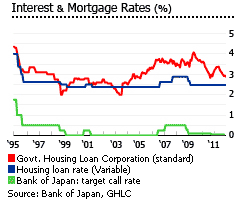
The BOJ’s key interest rate has been “virtually zero” (0% - 0.1%) since October 2010, and below 1% since mid-1990s. Bank variable interest rates in Japan have hardly moved since 2000, remaining at 2.475% in December 2011.
Yet demand for loans remains weak, given the recent financial crisis, and the earthquake‘s impact. The ratio of outstanding home loans to GDP remains very much lower in Japan than in other developed countries, at around 24.5%.

Could a reason for lacklustre demand for housing loans be low rental returns? Global Property Guide research suggests that rental yields in Tokyo fell from an average of 5.5% in 2009, to 4.8% in 2011, findings consistent with trends shown in IPD-Recruit residential data (see chart below). However if Tokyo prices have been rising ahead of rents, weak loan demand is less likely to reflect a specific reluctance to buy versus rent, and more a general reluctance to spend on any kind of housing.
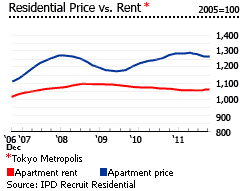
Hints of recovery
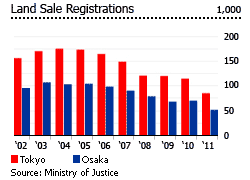
Japan was seriously affected by the global financial crisis in 2008 and 2009, and following that house prices fell by up to 4% nationally, and by almost 8% in the six major cities. However, Japan’s economy bounced back in 2010, and there were strong new condominium sales in Tokyo, with the number of dwelling units sold up 22.5%, according to the Real Estate Economic Institute. The increase was helped by the enhanced mortgage tax break carried over from 2009.
Property sales are now rising sharply. In Tokyo, the total number of condos sold rose 15.9% to 36,567 units in 2013 from a year earlier, according to LIJ. Likewise, in Osaka, the number of condos sold increased by 10.4% y-o-y to 16,654 units in 2013.
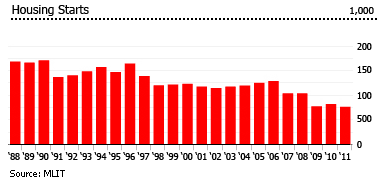
In 2013, residential construction was at its strongest in more than a decade, with an 11% y-o-y rise in new dwelling starts. New dwelling starts continued to increase in early 2014, rising 12.3% to 77,843 units in January 2014 compared to the same period last year, according to the Ministry of Land, Infrastructure, Transport and Tourism (MLIT). Likewise, the total floor area of new dwellings started increased by 10.5% to about 6.76 million sq. m. Most residential construction is occurring in Tokyo, which accounted for about 40% of all new dwellings started. Osaka accounted for about 12% while Nagoya for 8% of all new dwellings started.
Trade deficit continues to grow
Japan’s trade deficit continues to grow. In 2013, Japan saw a record trade deficit amounted to JPY11.5 trillion (US$112.7 billion), up 65.3% from a year earlier. Prolonged deterioration in the country’s trade balance is expected to erode its position as a net creditor, one of Japan’s main credit strengths, according to Moody’s Investors Service. This is surprising, given the yen’s decline.
In addition, the country’s fiscal health is the worst among major industrialized countries, with a public debt equivalent to more than 200% of GDP. In 2013, the country’s central government debt topped JPY1,000 trillion (US$9.8 trillion) for the first time in its history.
Healthy economic growth in 2013

From 2000 to 2007, the Japanese economy grew by an average of 1.5% annually. However due to the global financial meltdown, the economy contracted by 1% in 2008 and by another 5.5% in 2009. The economy returned to growth in 2010 with GDP growth of 4.7%. Then Japanese growth contracted again, shrinking by 0.5% in 2011 due to the impact of the Great Tohoku Earthquake (magnitude 9.0) last March 11, 2011. In addition the economic slowdown in China, Japan’s largest export market, exacerbated the situation. Then there was the anti-Japanese feeling in China sparked by the dispute over Diaoyu/Senkaku Islands. The economy grew by an anaemic 1.4% in 2012 and by another 1.5% in 2013.
The Japanese economy is expected to expand by 1.4% this year and by 1% in 2015, according to the International Monetary Fund (IMF).
In an effort to boost economic growth, Prime Minister Shinzo Abe, came to power in December 2012 with a program of reflationary policies, widely referred to as “Abenomics”, including the following:
- Inflation targeting at 2%
- Correction of the excessive appreciation of the yen
- Negative interest rates
- Radical quantitative easing
- Expansion of public investment
- Buying of construction bonds by the Bank of Japan
- Revision of the Bank of Japan Act
Effective April 1, 2014, the sales tax was increased from 5% to 8%. The sales tax is expected to rise again to 10% in October 2015.
Inflation increased to 1.6% in March 2014, up from 1.5% the previous month and in sharp contrast with a deflation of 0.9% in the same period last year, according to Stat Bureau Japan. Consumer prices rose by 0.4% in 2013, after falling for four straight years (-1.3% in 2009, -0.7% in 2010, -0.3% in 2011 and -0.04% in 2012), according to the IMF.
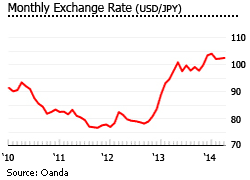
However, Abe risks losing public support. The new sales tax combined with price increases of commodity goods (e.g. dairy products, meat, gasoline and electricity) could pressure the consumer, given inadequate wages growth. Consumer confidence dropped for a fourth straight month in March 2014.
“Households are already seeing their real incomes eroding and it will get worse with faster inflation,” said Taro Saito of NLI Research Institute.
In fact, the OECD recently warned the Japanese government that the economy may suffer a slowdown if inflation continues to rise without wage expansion. As a result, the OECD downgraded its 2014 economic growth forecast for the third largest economy to 1.2% from an initial 1.5%.
“While the recent pick-up in inflation is encouraging, it could undermine the recovery unless it is accompanied by a matching rise in wages,” the OECD said.
The yen weaken sharply by 18% to an exchange rate of JPY103.46 = US$1 during the year to December 2013, mainly due to Abe’s policies. However the yen reversed direction during the first four months of 2014, gaining 1.5% against the U.S. dollar. At time of writing, the exchange rate stood at JPY101.98 = USD1.
